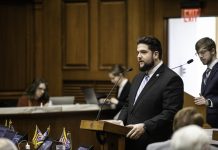State Agencies Asked To Cut Spending As Indiana Faces Economic Consequences Pf COVID-19
By Erica IrishÂ
TheStatehouseFile.com
INDIANAPOLIS — As most of Indiana entered its next phase of reopening from shutdowns imposed to limit the spread of COVID-19, state leaders announced Friday new measures to cut costs as the state records plummeting reserves.
Amid the reopening, which is now in Stage 3 of a five-stage plan for all counties except Marion, Lake, and Cass, Gov. Eric Holcomb said state agencies will be asked to reduce their budgets by 15% for the fiscal year 2021. This is in response to sharp declines in state revenues because of business closures and job losses caused by the pandemic. The State Budget Agency reported earlier this month that April revenues fell short of annual estimates by more than $1 billion and the downward trend is expected to continue in the coming months.

Holcomb said in a virtual press briefing Hoosiers won’t lose access to the essential services state agencies provide as the COVID-19 crisis continues. The Indiana State Department of Health reported an additional 493 cases Friday, bringing the state total to 30,409. An additional 27 residents died from the virus, leaving the death toll at 1,791.
“That’s the whole point of this — that we are not cutting those essential services that Hoosiers need,†Holcomb said. “And that’s why we’re asking our state agencies to tighten their belts, to look at any cost savings that they can possibly find.â€
Indiana Office of Management and Budget Director Chris Johnston said state agencies have been asked to submit strategic plans to prioritize projects and cut costs. The state will also not move forward on several projects, including $291 million in capital projects that were to be paid for with the state’s reserves and $110 million in deferred maintenance to areas like state parks.
Johnston and Holcomb said these are only the first steps in cost-saving measures as the state awaits answers on assistance from the federal government and state revenue.
“Everything is on the table, I believe,†Johnston said. He noted the state’s response will be “an evolving process†that combines federal relief, spending cuts, and state reserves.
Johnston said the immediate cost reductions won’t apply to K-12 and higher education spending, which consists of around half the state’s biennium budget.
The Indiana Department of Workforce Development also revealed Friday the state unemployment rate now stands at 16.9%, which is greater than the 14.7% nationwide unemployment rate. Each rate reflects how many people seeking employment within the last four weeks as a percentage of the labor force and is recorded from a survey managed by the U.S. Bureau of Labor Statistics.
Indiana Department of Workforce Development Commissioner Fred Payne said Friday the state has spent an estimated $1.7 billion on unemployment insurance since March. Around $500 million of that cost came from state funds, while the federal government paid for $1.2 billion.

The majority of jobs lost came from the manufacturing industry and the leisure and hospitality sectors, which saw a combined 194,200 jobs lost, according to data from the Department of Workforce Development.
Michael Hicks, a professor of economics and director of the Center for Business and Economic Research at Ball State University, said the state will need to be prepared to address the increased cost of unemployment insurance claims. He pointed to the state’s $2.4 billion surpluses as one solution.
“That $2.4 billion rainy day fund should actually sustain state government if they borrowed against unemployment insurance well into next year,†Hicks said. “If they don’t borrow against unemployment insurance, it will be gone in another, you know, two months, three months, maybe four months.â€
Regardless of the solution, though, Hicks said the consequences of not responding to the increased unemployment insurance costs could be dire.
“It would be wildly irresponsible not to borrow the full amount of the unemployment insurance spike that we have right now,†Hicks said.
​Hicks also said the downturn will likely exacerbate areas already in need of additional support, including issues in K-12 education like teacher pay and technology access.
“The shortfalls we’re about to face did not come at a time when we were actually meeting our budget needs in K-12 education and elsewhere,†Hicks said.
“Of course, this could all be fixed by a significant federal injection of cash, to save state and local governments,†Hicks said. “If that doesn’t happen, I think we’re going to take what’s already likely to be a bad recession and slide it into a depression.â€
FOOTNOTE: Erica Irish is a reporter for TheStatehouseFile.com, a news website powered by Franklin College journalism students.Â




